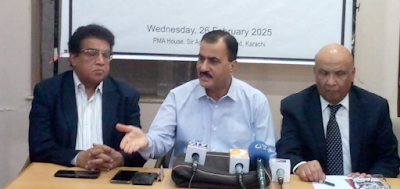Sindh data flags Hyderabad, Larkana as continued HIV epicentres
The province records an average of 269 new HIV cases every month since January 2024; Mirpurkhas saw a staggering 110pc spike in HIV cases in last quarter of 2024; data shows shifting HIV trends across Sindh, with sharp surges in Karachi’s Malir district; in the absence of transparent data and evidence-based action, Sindh risks deepening HIV crisis
By Mukhtar Alam
KARACHI: Hyderabad and Larkana, which
ranked first and second, respectively, among Sindh’s six high-burden HIV
districts in 2024, have maintained their troubling positions in 2025. Together,
they account for 187 new HIV cases so far this year — representing 22% of the
province’s 856 registered cases — compared to a combined 637 cases (18% of
3,446 total infections) last year, according to a new analysis of the
district-level data.
In contrast to persistent transmission
challenges in these two districts, Mirpurkhas — previously the third most
affected district— recorded a significant decline, falling to fifth place with
36 new cases so far in 2025, compared to 221 cases of last year. Conversely,
Karachi’s Malir district, which ranked sixth in 2024, has experienced a sharp
rise, climbing to second position in 2025, matching Larkana with 64 cases so
far this year.
District-wise HIV data highlights shifting trends and emerging challenges in Sindh; however, officials from the provincial CDC-HIV wing and the Health Department did not make the data available officially, nor did they volunteer a discussion on the subject, despite repeated requests by this reporter.
Data obtained through alternative sources
indicate that Mirpurkhas — which topped the list of HIV-infected children in
2024 with 150 cases — has reported 21 HIV-infected children so far in 2025. The
Sindh Health Department has yet to provide an explanation for the extraordinary
surge in pediatric HIV cases in Mirpurkhas in 2024.
Other districts reporting high numbers of HIV
cases in children in 2024 were Hyderabad (61), Larkana (52), Shikarpur (46),
Jacobabad (38), and Khairpur (23). The leading districts so far this year are:
Hyderabad (28), Mirpurkhas (21), Larkana (16), Shikarpur (8), Khairpur (7),
Shaheed Benazirabad (7), and Kambar Shahdadkot (6).
As for transgender persons, data reveal that 52
individuals (6% of total new cases) tested HIV-positive so far this year,
compared to 254 (7%) in 2024 — reflecting persistent vulnerabilities and gaps
in health safety measures among this community.
Districts reporting the highest numbers of HIV-positive transgender persons in
2024 included Hyderabad (42), Karachi Central (33), and Karachi South (29). The
corresponding figures for 2025 so far are: Hyderabad (7), Karachi’s Malir
district (7), Khairpur (5), Karachi’s Korangi district (5), and Larkana (4).
An overall review of district trends shows that
HIV cases recorded till September 2024 were: Hyderabad (273), Larkana (173),
Mirpurkhas (105), Karachi South (136), Khairpur (127), and Karachi’s Malir
district (120). These figures rose significantly in the final quarter of last
year, with year-end figures recorded as: Hyderabad (401), Larkana (236),
Mirpurkhas (221), Karachi South (184), Khairpur (174), and Karachi’s Malir
district (166).
This sharp increase translates into three-month surges of 110% in Mirpurkhas, 47%
in Hyderabad, and 36% in Larkana — a serious public health development for
which authorities have yet to provide clear explanations, according to sources.
Cumulatively, from 2014 to August 2024, Sindh
had listed 24,891 people living with HIV. Although recent details on modes of
exposure have not been made public, data compiled by the CDC-HIV wing of the
Sindh Health Department in 2023 identified the following primary transmission
modes (up to August 2024):
Sexual transmission (7,901 cases), reuse of contaminated needles/injections
(6,911 cases), transfusion of blood or blood products (2,131 cases),
mother-to-child transmission (1,069 cases), occupational/healthcare settings
(181 cases), and surgical/dental procedures (12 cases). An additional 2,128 cases
had undisclosed transmission methods.
Fresh data suggests an average of 269 new HIV cases being reported monthly across Sindh since January 2024 -- 140 men, 65 women, 27 male children, 18 female children, and 19 transgender persons.
Experts warn of worsening
HIV control gap
Health experts stress that the authorities need to strengthen Sindh’s HIV control measures on urgent basis. “Efforts remain fragmented and lack strategic direction from those at the helm, while the situation demands serious, coordinated interventions to control this growing public health threat across the province,” a source close to the provincial health circle observed.
A public health specialist on infectious
diseases, requesting not to be named, emphasised: “These persistent and shifting
HIV trends underline a systemic failure in both prevention and surveillance
mechanisms. Targeted outreach for key populations, improved paediatric
screening, and stronger infection control practices are urgently needed. In the
absence of transparent data sharing and evidence-based interventions, Sindh
risks further escalation in HIV epidemic.”
Originally published by Social Track, Karachi (25.4.2025)








One of the main reasons of HIV prevalence in Hyd and LRK is the complete failure of SHCC to take actions on quack clinics ( 30% of overall HiV rise is due to rise in Quackery ) which is the mandate of SHCC and the reason why it was formed in the first place.
ReplyDelete